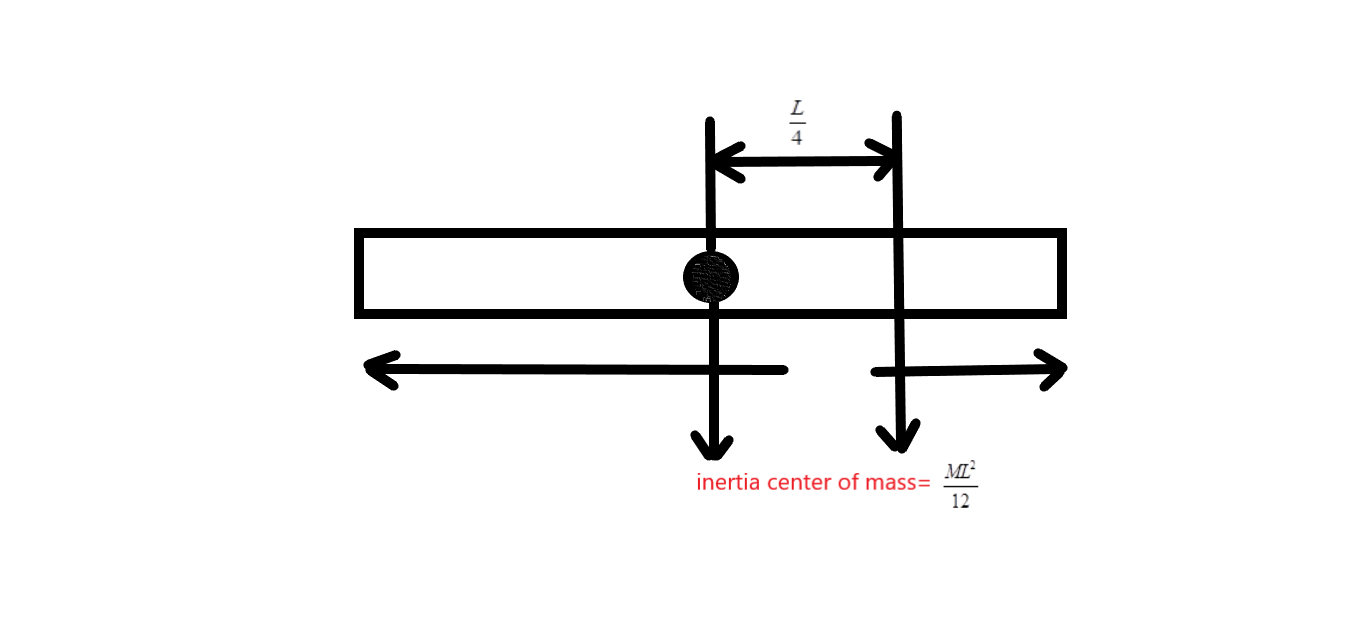
Moment of inertia of a thin rod of mass M and the length L about an axis passing through its center is $\dfrac{{M{L^2}}}{{12}}$ , its moment of inertia about a parallel axis at a distance of $\dfrac{L}{4}$ from this axis is given by
$
A.{\text{ }}\dfrac{{M{L^2}}}{{48}} \\
B.{\text{ }}\dfrac{{M{L^3}}}{{48}} \\
C.{\text{ }}\dfrac{{M{L^2}}}{{12}} \\
D.{\text{ }}\dfrac{{7M{L^2}}}{{48}} \\
$
Answer
589.2k+ views
Hint: Parallel axis theorem, is also known as the Huygens-Steiner theorem. Parallel axis theorem is used to analyze the moment of inertia for an object that is rotating around the axis i-e that doesn’t go through the center of mass.
Complete step-by-step answer:
 This figure above will make this question easy to understand. All the given terms are mention in this figure above,
This figure above will make this question easy to understand. All the given terms are mention in this figure above,
Now, according to parallel axis theorem:
$
I = {I_{com}} + m{x^2} \\
where{\text{ x = distance between the axis and center of mass}} \\
{\text{here x = }}\dfrac{l}{4} \\
I = \dfrac{{M{L^2}}}{{12}} + M \cdot {\left( {\dfrac{l}{4}} \right)^2} \\
\Rightarrow \dfrac{{M{L^2}}}{{12}} + \dfrac{{M{L^2}}}{{16}} \\
now,{\text{ taking LCM we get,}} \\
\Rightarrow \dfrac{{4M{L^2} + 3M{L^2}}}{{48}} = \dfrac{{7M{L^2}}}{{48}} \\
$
The term moment of inertia is also known as mass moment of inertia. It is defined as the ratio of net angular momentum of a system to its angular velocity around the principal axis. Moment of inertia plays a very important role in physics which means that in physics problems that involve the mass in rotation motion and that are calculated by angular momentum.
THERE ARE THREE TYPES OF INERTIA:
i. INERTIA OF REST
ii. INERTIA OF MOTION
iii. INERTIA OF DIRECTION
If the moment of inertia is increased there will be a slowing down process of speed of rotation. We can also say that the moment of inertia of the body is directly proportional to the mass and it increases as the mass moves further from the axis of rotation.
Therefore option (D) is the right answer.
Note: Don’t get confused in saying that the moment of inertia and the inertia is the same in nature in physics. No it is not inertia means just the state of the body either it is in motion or rest whereas the moment of inertia is the measurement of resistances of the object against the rotation.
Complete step-by-step answer:

Now, according to parallel axis theorem:
$
I = {I_{com}} + m{x^2} \\
where{\text{ x = distance between the axis and center of mass}} \\
{\text{here x = }}\dfrac{l}{4} \\
I = \dfrac{{M{L^2}}}{{12}} + M \cdot {\left( {\dfrac{l}{4}} \right)^2} \\
\Rightarrow \dfrac{{M{L^2}}}{{12}} + \dfrac{{M{L^2}}}{{16}} \\
now,{\text{ taking LCM we get,}} \\
\Rightarrow \dfrac{{4M{L^2} + 3M{L^2}}}{{48}} = \dfrac{{7M{L^2}}}{{48}} \\
$
The term moment of inertia is also known as mass moment of inertia. It is defined as the ratio of net angular momentum of a system to its angular velocity around the principal axis. Moment of inertia plays a very important role in physics which means that in physics problems that involve the mass in rotation motion and that are calculated by angular momentum.
THERE ARE THREE TYPES OF INERTIA:
i. INERTIA OF REST
ii. INERTIA OF MOTION
iii. INERTIA OF DIRECTION
If the moment of inertia is increased there will be a slowing down process of speed of rotation. We can also say that the moment of inertia of the body is directly proportional to the mass and it increases as the mass moves further from the axis of rotation.
Therefore option (D) is the right answer.
Note: Don’t get confused in saying that the moment of inertia and the inertia is the same in nature in physics. No it is not inertia means just the state of the body either it is in motion or rest whereas the moment of inertia is the measurement of resistances of the object against the rotation.
Recently Updated Pages
Why are manures considered better than fertilizers class 11 biology CBSE

Find the coordinates of the midpoint of the line segment class 11 maths CBSE

Distinguish between static friction limiting friction class 11 physics CBSE

The Chairman of the constituent Assembly was A Jawaharlal class 11 social science CBSE

The first National Commission on Labour NCL submitted class 11 social science CBSE

Number of all subshell of n + l 7 is A 4 B 5 C 6 D class 11 chemistry CBSE

Trending doubts
Differentiate between an exothermic and an endothermic class 11 chemistry CBSE

10 examples of friction in our daily life

One Metric ton is equal to kg A 10000 B 1000 C 100 class 11 physics CBSE

Difference Between Prokaryotic Cells and Eukaryotic Cells

1 Quintal is equal to a 110 kg b 10 kg c 100kg d 1000 class 11 physics CBSE

State the laws of reflection of light




